iPad mini Review
by Anand Lal Shimpi & Vivek Gowri on November 20, 2012 6:10 PM ESTDisplay Analysis
As with a discussion on performance in mobile devices these days, the iPad mini's display requires both an experiential analysis and an objective performance analysis. I'll begin with the experience.
Without a doubt, the iPad mini presents an evolution in form factor and nothing else. Everything from silicon to display technology are known quantities at this point. While it's true that in many senses, even Apple's previous generation mobile hardware is pretty good, the fact of the matter remains that the mini doesn't push the envelope in anything but form factor. That's not necessarily a bad thing, it's just reality. I should also point out that many smaller-versions-of-bigger-things follow this same approach of not pushing the performance envelope for obvious reasons.
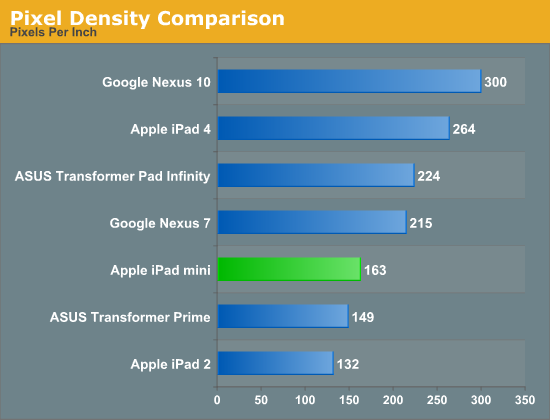
Doing the math on the mini's 1024 x 768 display results in a pixel density of 163 pixels per inch. A tangible improvement compared to the original iPad's 132 PPI, but keep in mind the smaller screen may have to be held closer to your eyes. Compared to other tablets, the mini's display resolution isn't anything to write home about. In practice, the mini's makes reading small text a problem:

While the 3rd and 4th gen iPads have a large enough display at a high enough resolution to make it possible to view the Dell configurator in the photo above without zooming, the same can't be said for the iPad mini. You're going to need a double tap.
Although reading text is one area where the absence of insane numbers of pixels is clearly obvious, it's visible in some photos as well.

iPad mini (left) vs. iPad 4 (right)
Where a lack of fine detail doesn't get you, the physical size of the display may. I was pleasantly surprised by the usefulness of Apple's 7.85-inch display, but given my early affinity towards 8-inch tablets it's not too shocking. Despite how useful the mini's display is, I found myself having to double tap to zoom in on most desktop websites just to make the reading a bit better. It's not that the process of zooming in on a website in mobile Safari is particularly cumbersome, it's that the fact that I have to makes me feel like I'm using more of an iPod Touch and less of an iPad. I do admit the feeling is quite irrational as I prefer keeping the iPod Touch (or iPhone in the case of, reality) holstered and using the mini instead. This is less a criticism of the iPad mini and more guidance for those deciding between mini and regular sizes of the iPad.
Compared to a true 7-inch tablet like the Nexus 7, the additional screen size is definitely appreciated - particularly when reading web pages:
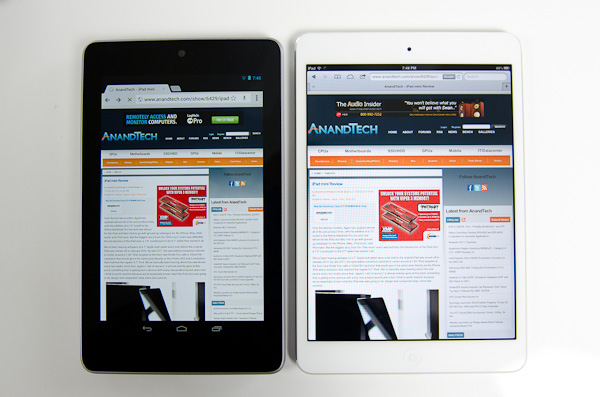
Nexus 7 (left) vs iPad mini (right)
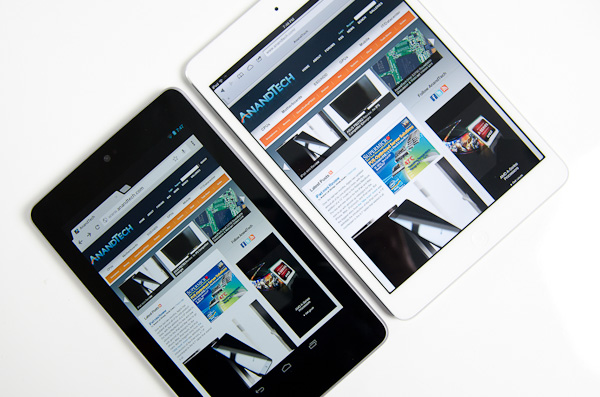
Nexus 7 (left) vs iPad mini (right)
When Vivek and I brought up the topic of the mini's lower pixel density on the Podcast, our own Brian Klug pointed out the obvious: we're spoiled. How impressed/unimpressed you are with the iPad mini's display really depends on what other displays you've been exposed to. In a vacuum, the iPad mini's display is fine. Brightness, black levels and contrast are all reasonable (and much better than most notebooks). Color reproduction isn't bad either. In the spectrum of all displays available at the mini's price point, this 7.85-inch 1024 x 768 panel isn't bad. Spend any appreciable time with the bigger iPad's Retina Display however, and your opinion will quickly change.


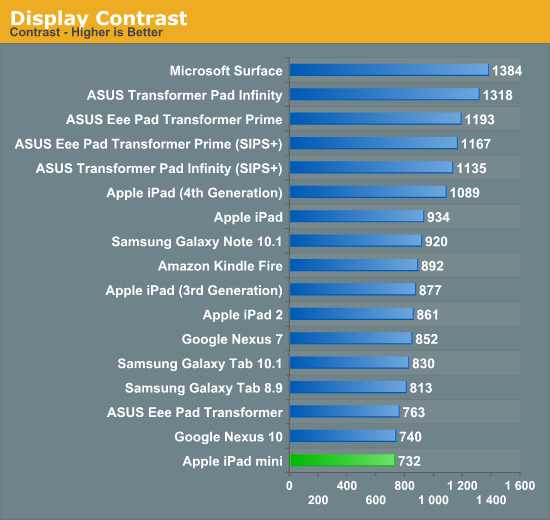
In our Surface review I titled the display section "Not Retina, But Still Good". Compared to the Surface display, the mini has better color accuracy but clearly loses out in black levels thanks to Microsoft's laminated display + cover glass stack.
To evaluate color accuracy I turned to our own Chris Heinonen's CalMAN smartphone/tablet workflow. We'll start off by looking at the calibrated white point for these tablets. What you're looking for here is a number close to 6500K:
The mini doesn't really diverge from other iPads here, although Microsoft comes closer to 6500K at 200 nits.
The next three charts look at accuracy represented as a difference between various source colors and what's reproduced on the display. The results are presented as average dE2000, with lower numbers being better.
First up is Grayscale performance, here we're looking at the accuracy of black, white and 19 shades of gray spread in between the two extremes:
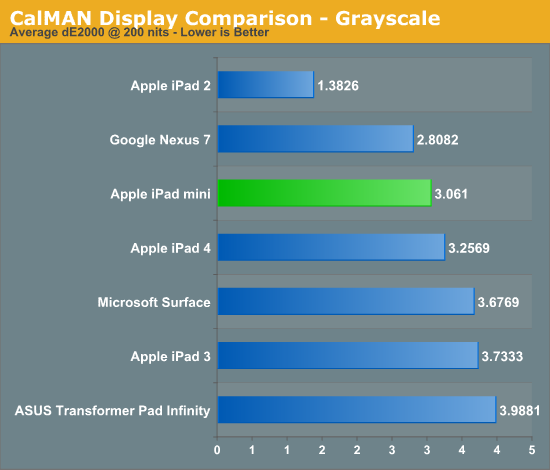
The mini does reasonably well here, it actually ends up a bit better than the 4th gen iPad. Grayscale accuracy doesn't seem to be too difficult for most folks to get right, but what happens when we start looking at colors?
First in our color accuracy tests is a saturation sweep. Here we're looking at 20%, 40%, 60%, 80% and 100% saturations of red, blue, green, magenta, yellow and cyan.
Now we start to see the retina equipped iPads pull away from the mini. Compared to the iPad 2 and even Microsoft's Surface, the mini looks pretty good, but if you compare it to the Nexus 7 or newer iPads it's clearly at a disadvantage. All of these displays are significantly better than the average notebook panel. As I mentioned earlier, it all boils down to perspective and expectations.
Gamut CIE Chart

Saturation CIE Chart

For our final accuracy test we're looking at the difference between a Gretag Macbeth colorchecker chart and the rendered swatches on these displays. Once again, lower numbers are better.
Once again, the iPad 3/4 can't be touched here, with the iPad mini falling significantly behind. Colors simply look better on the bigger iPads. The Nexus 7 does better here as well. Subjectively I found colors on the Nexus 7 to look appreciably more accurate than on the mini.
GMB Color Checker
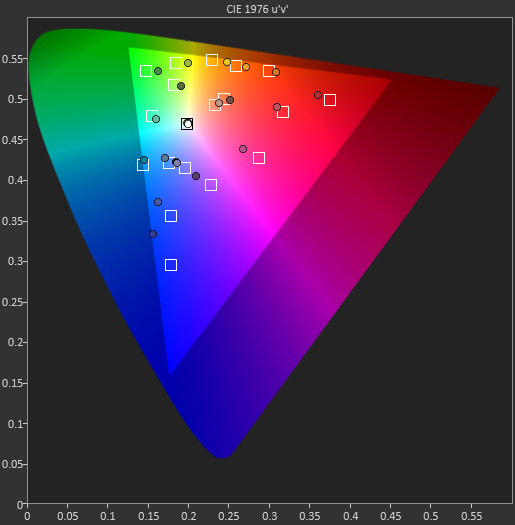
With regards to the quality and accuracy of the images rendered on the mini's screen, I feel the same way about it as I do the display on Surface: it's not a Retina display, but still good.


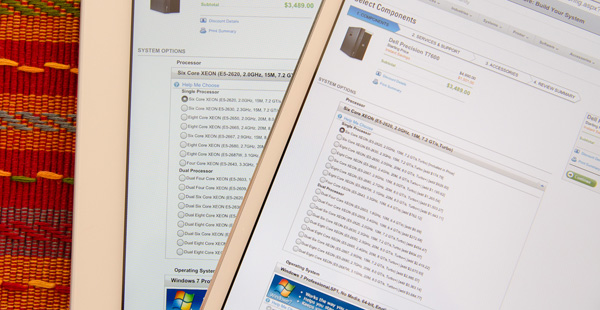
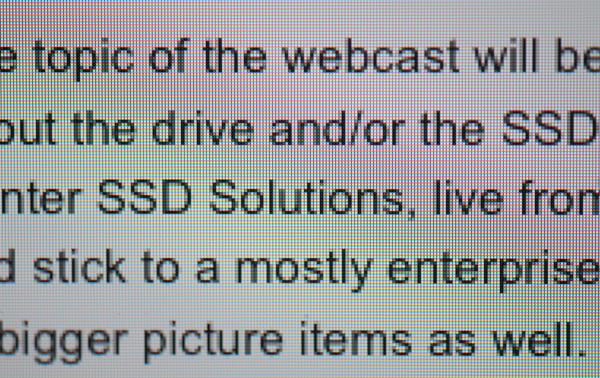
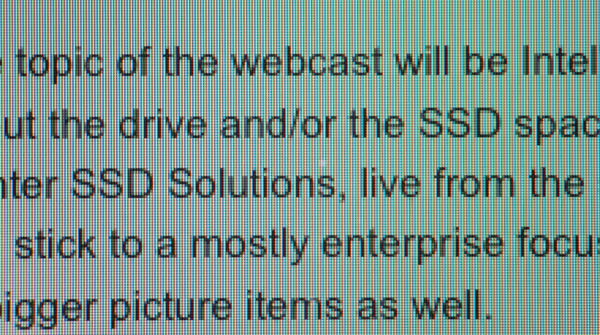
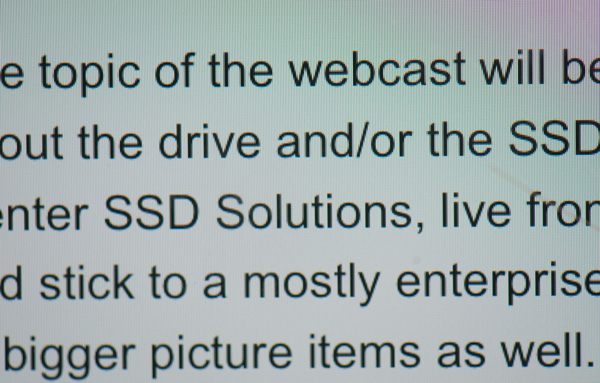
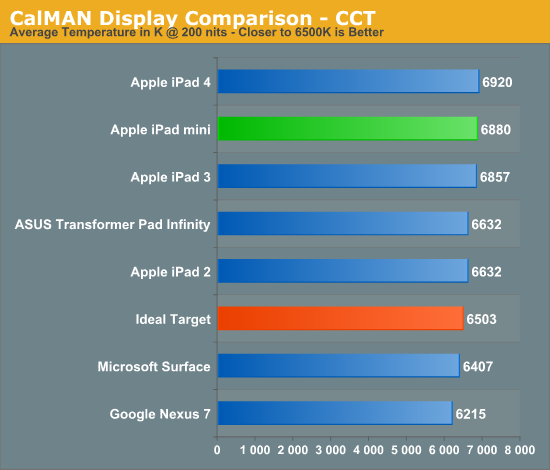
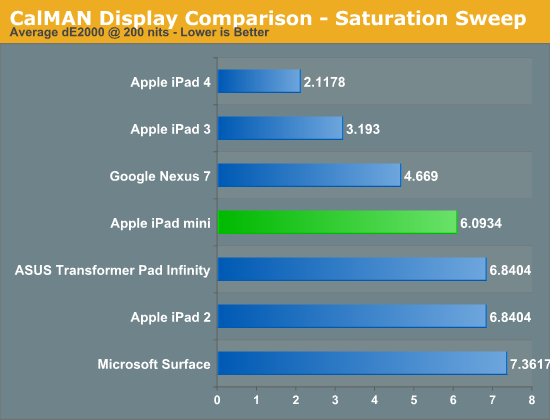
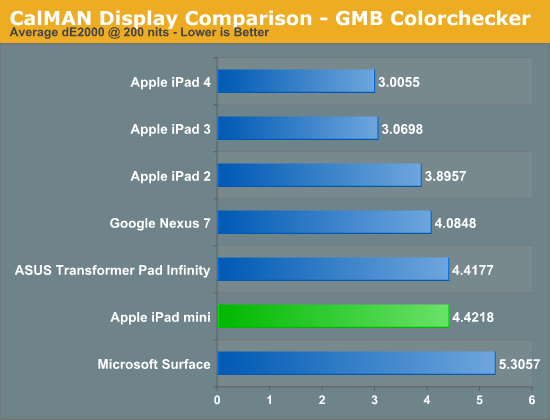








140 Comments
View All Comments
menevets - Friday, November 23, 2012 - link
I own an iPad and debated between the Mini and the Nexus 7. I went with the Nexus 7.Without rooting, I can copy files from camera to external hard drive without resorting to wifi or buying anything extra. GPS, turn by turn voice navigation, offline maps, easy integration with Google tools like Mail, Picasa Web, YouTube, etc... I can see why someone would want a wider screen, but the narrower N7 can fit in more pockets and make for easier holding on the train. And in general, there is much more detail in settings.
The N7 is sorely missing a rear facing camera. I like to photograph articles, documents, basically text. The 1.2 megapixel front facing camera is not enough to capture text clearly. The build quality is a little suspect, for example, the screen lifting problem.
Jelly Bean, in general, may be more buttery smooth than its predecessors, but it is much easier navigating iOS, selecting text, scrolling, etc... iOS is much more responsive.
Obviously iOS app selection is better, but I notice that Android equivalent apps are not as good. For example, the Kindle app on iOS, when you highlight a word on the bottom of the screen, the definition appears on the top, which allows you to alter the highlighting selection. The Android version, the definition covers the bottom so you can't change the highlighting selection. I noticed other instances of how the iOS app works better than its Android equivalent. Dropbox, Evernote for example.
Google Play has a limited selection of movies and tv shows compared to iTunes/Amazon.
So my use case for the big iPad is reading music scores from the piano, reading books with complex formatting, reading novels at home - fewer page turns, videos and apps I can't get on Android. The N7 for everything else.
So the above N7 drawbacks for me are well worth the $130 savings.. Hope this helps others in their decision.
Rodney McKay - Friday, November 23, 2012 - link
I went to an Apple store today (Black Friday) planning to buy a 4th-gen iPad on sale. Though I hadn't yet seen a mini, I dismissed it out of hand because I "wanted a retina display". It happened that there was a mini next to a iPad 4 on display, so I compared them. The resolution difference wasn't really obvious to me (after all, the mini has a higher pixel density than the iPad 2), and in reading text (web pages, for example) I felt no clear preference. The mini's display was somewhat yellower/warmer than the 4's, which I didn't much care for. However, I opened Apple Maps on both, and was shocked to see that that the mini had a MUCH clearer display than the 4. On the mini, the smallest streets were clear at the zoom level where they appeared, but on the 4 they were so washed out as to be almost invisible. And in pretty much every other respect, the mini's Maps display looked better. I spent half an hour mucking with brightness and zoom levels trying to equalize the displays for a fair test, but no matter what I did the mini display was dramatically better.So, I tried an iPad 2 next to a 4, and got exactly the same results. The 2's display looked very much like the mini's (albeit larger), with map details much clearer than on the 4 (a *different* 4 from the one I compared to the mini, so this wasn't just a sample glitch with that particular iPad). I called over a store rep and showed him my results. He said "Hmm... but the Retina Display is better on things like photos and videos. Watch..." and he brought up the same sample image on both. We were both surprised to see that the image on the 2 was again dramatically nicer (less washed out, in particular) than on the 4, and at that point I realized that the real difference is that the 4's display has rather poor contrast (for which there is no adjustment), which would account for all the differences I observed.
I very much prefer the Retina Display on my iPhone 4s (and my wife's 5) over the previous ones, but on the iPads it seems to be significantly flawed (at least with the two samples I tried). I left the store with an iPad mini, even though it was the only iPad not on sale today.
I have a feeling that iPad reviewers haven't really been doing side-by-side comparisons between models. I dread the day when the iPad mini gets "upgraded" with a Retina Display--maybe I'll stock up on them now.
SanX - Sunday, November 25, 2012 - link
ROTFL go to the eye doctorusually only technical illiterates or salespeople having merchant interest write such bs
miatadan - Saturday, November 24, 2012 - link
I had the iPad 2 for a while and sold it as too large to take it with me daily. I purchased the wifi 32GB black model.It is the apps available for iOS that make the iPads attractive. I use n-Stream for Naim network player, use it as remote with Logitech app. Skype works well, Textplus for free texting nice.
I tried Rim blackberry playbook, liked actual hardware but no apps I could use....
Even with Targus case Mini iPad fits inside pocket of winter jacket when walking, hopefully once summer comes around I find summer jacket with large enough inside pocket.
Regular iPads at work feel heavy now compared to Mini, so I agree with Anand.
SanX - Sunday, November 25, 2012 - link
You wrote "It pains me to say it, but compared to most similarly priced notebooks, the iPad mini's display is amazing."Should be "It pains me to say it, but compared to most similarly priced notebooks, the iPad mini's display is amazing trash. I really do not know what's went wrong with Apple and in which city dump near Cupertino they found such display"
jameskatt - Sunday, November 25, 2012 - link
The problem of going the Full Retina Display Route is that that is an even ultra higher resolution than the iPad 3-4. And the battery and GPU needed would make it heavier, larger, and more expensive. This is thus not the route.Apple can more easily make the iPad Mini like the iPhone 5: increasing the vertical resolution and not forcing existing apps to rerender. They just keep working as before but with letter-boxing. This solution would increase the resolution so it is Retina-like and would work with existing apps.
MobiusStrip - Monday, November 26, 2012 - link
Another idiotic glossy screen.iSee - Monday, November 26, 2012 - link
These are also all reasons the iPad and iPhone can't have retina displays.Hm.
Alex Veit - Wednesday, November 28, 2012 - link
If you give someone $5 they will ask "why didn't you give me" $10.Just the fact that most applications that a few years ago could only be performed on a desktop or laptop are now being implemented in handheld devices is freaking awesome!!
who cares about the minor dimension differences in between the devices.
By the way, if you own an iPad and you want to get the most out of it http://d7a79zq53j51xd1830fjvzkexx.hop.clickbank.ne...">Click
here to get some awesome stuff.
EarthCore - Thursday, May 30, 2013 - link
AnandTech "unbiased" tests always seem to be skewed toward Apple. The Nexus 7 can easily get 13+ hours runtime looping a 720p movie:http://forum.xda-developers.com/showthread.php?t=2...